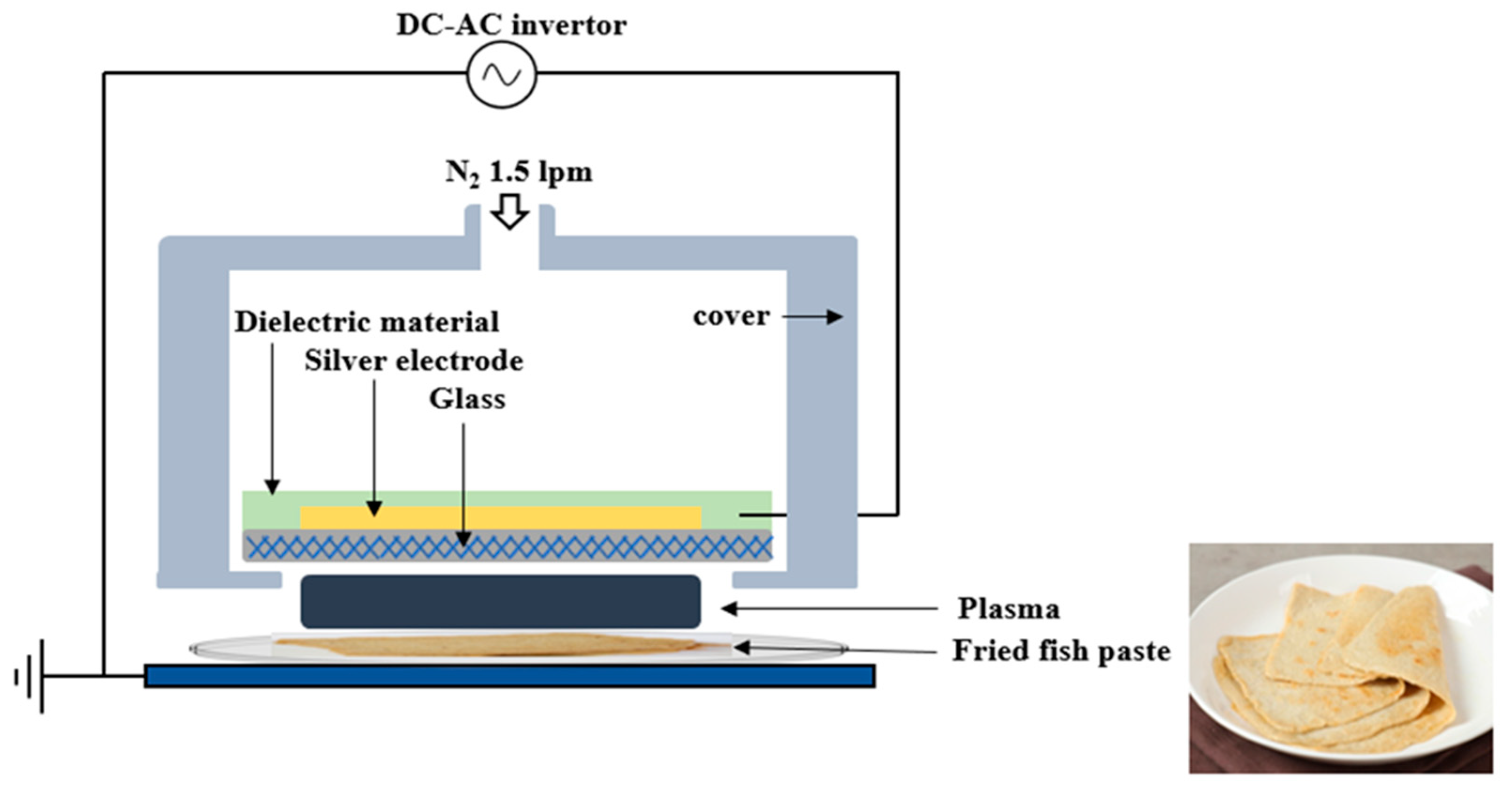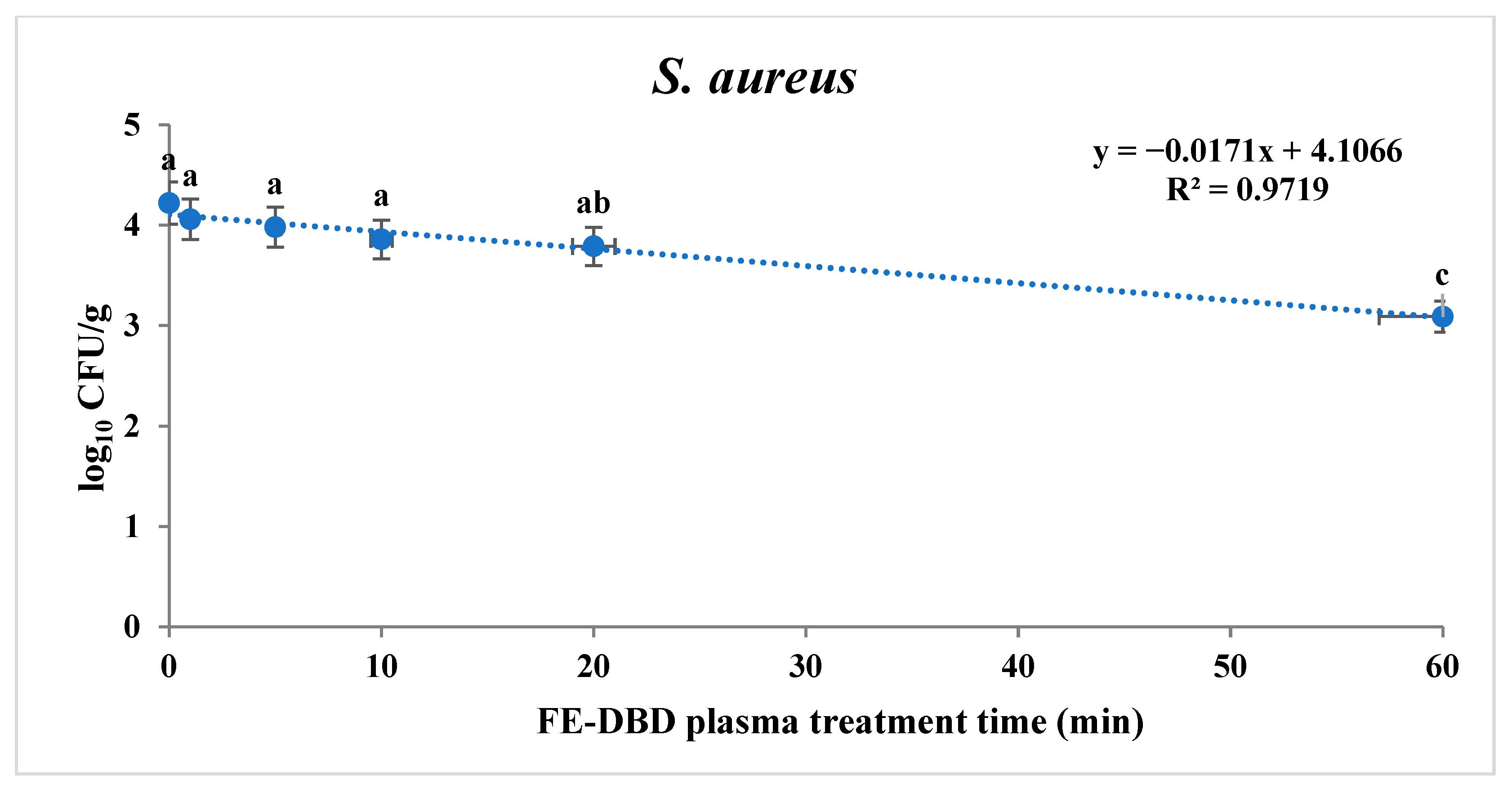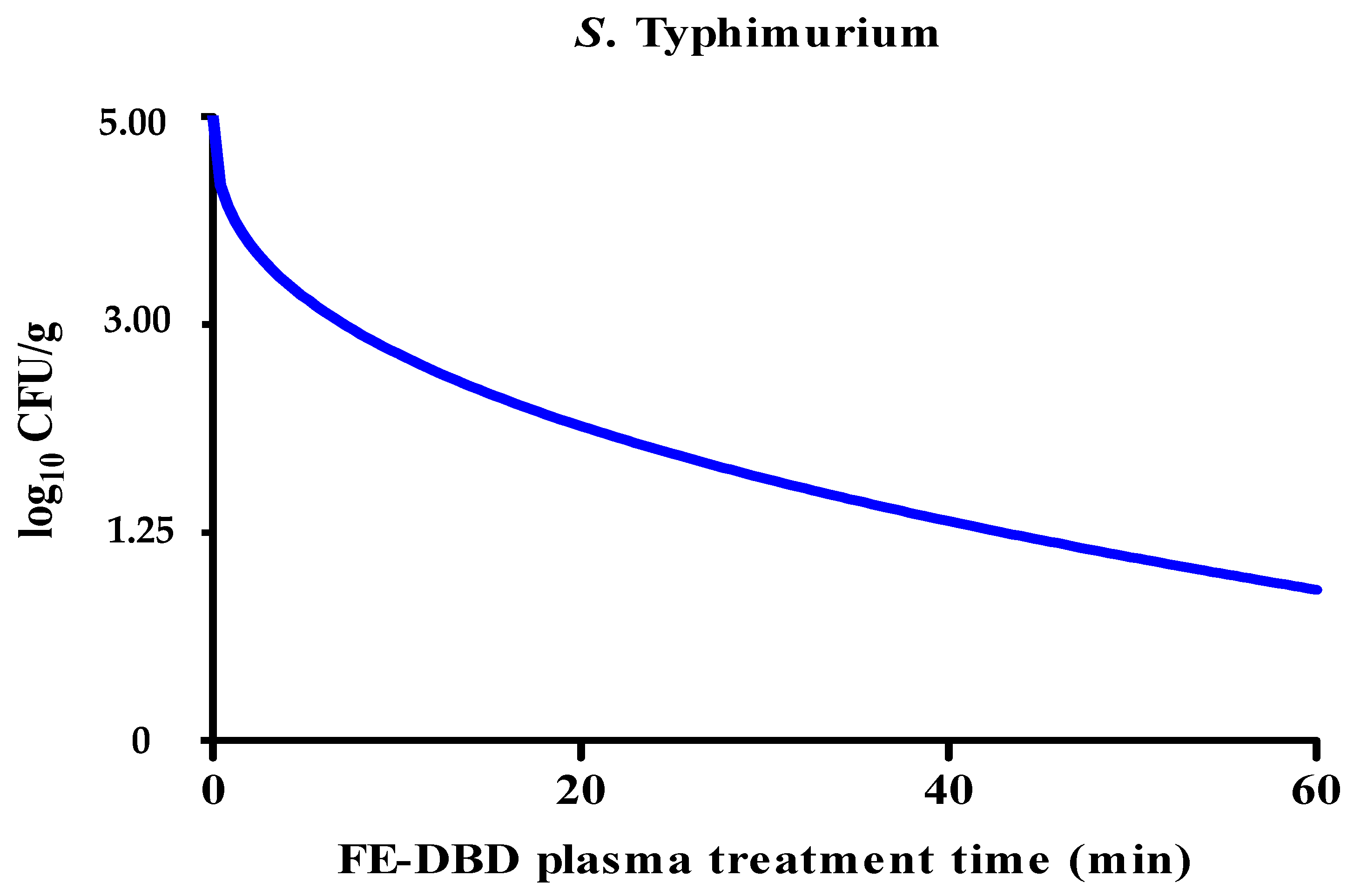The Efficacy of Floating Electrode-Dielectric Barrier Discharge Plasma against Staphylococcus aureus and Salmonella Typhimurium on Fried Fish Paste
Abstract
:1. Introduction
2. Materials and Methods
2.1. Sample Preparation and Bacteria Inoculation
2.2. FE-DBD Plasma Treatment on Fried Fish Paste
2.3. Quantification of Bacterial Analysis
2.4. Modeling of Decimal Reduction Times
- The initial microbial population (CFU/g) is N0.
- The microbial population multiplied by FE-DBD plasma treatment time (CFU/g) is N.
- The FE-DBD plasma treatment time (min) is t.
- The reduction rate constant is k.
- Nt is the number of microorganisms (log CFU/g) after the FE-DBD plasma treatment time, t.
- N0 is the initial microbial population (log CFU/g).
- t is the FE-DBD plasma treatment time (min).
- b indicates the time needed to reduce the population for one log unit.
- n (parameter) indicates the shape of the survival curve.
2.5. Physicochemical Quality Evaluation [pH Value, VBN]
2.6. Statistical Analysis
3. Results
3.1. Reduction and D-Value of S. aureus and S. Typhimurium in Fried Fish Paste after FE-DBD Plasma Treatment
3.2. Quality (pH and VBN) of Fried Fish Paste after FE-DBD Plasma Treatment
4. Discussion
5. Conclusions
Author Contributions
Funding
Institutional Review Board Statement
Informed Consent Statement
Data Availability Statement
Conflicts of Interest
References
- Shin, H.Y.; Lee, Y.J.; Park, I.Y.; Kim, J.Y.; Oh, S.J.; Song, K.B. Effect of chlorine dioxide treatment on microbial growth and qualities of fish paste during storage. J. Korean Soc. Appl. Biolo. Chem. 2007, 50, 42–47. [Google Scholar]
- Bashir, K.M.I.; Kim, J.S.; An, J.H.; Sohn, J.H.; Choi, J.S. Natural food additives and preservatives for fish-paste products: A review of the past, present, and future states of research. J. Food Qual. 2017, 2017, 31. [Google Scholar] [CrossRef]
- Ryu, H.S.; Choi, N.D.; Lee, S.Y. Food quality and shelf-life of Korean commercial fried Kamaboko. Korean J. Fish. Aquat. Sci. 2014, 47, 211–219. [Google Scholar] [CrossRef]
- Kim, J.H.; Jeon, J.Y.; Ryu, S.R.; Kim, Y.J.; Suh, C.S.; Lee, J.W.; Byun, M.W. Microbial quality and physiochemical changes of grilled fish paste in a group-meal service affected by gamma-irradiation. Korean J. Food Preserv. 2004, 11, 522–529. [Google Scholar]
- Kang, J.H.; Ra, C.H.; Kim, S.H.; Shon, H.W.; Chung, H.Y. Effects of bactocease treatment on microbial growth and quality of fried fish paste during storage. Food Eng. Prog. 2022, 26, 19–26. [Google Scholar] [CrossRef]
- Kim, J.S.; Cho, M.L.; Heu, M.S. Quality improvement of heart-induced surimi gel using calcium powder of cuttle, Sepia esculenta bone treated with acetic acid. Korean J. Fish. Aquat. Sci. 2003, 36, 198–203. [Google Scholar] [CrossRef]
- Butscher, D.; Van Loon, H.; Waskow, A.; von Rohr, P.R.; Schuppler, M. Plasma inactivation of microorganisms on sprout seeds in a dielectric barrier discharge. Int. J. Food Microbiol. 2016, 238, 222–232. [Google Scholar] [CrossRef] [PubMed]
- Liao, X.; Liu, D.; Xiang, Q.; Ahn, J.; Chen, S.; Ye, X.; Ding, T. Inactivation mechanisms of non-thermal plasma on microbes: A review. Food Control 2017, 75, 83–91. [Google Scholar] [CrossRef]
- Misra, N.N.; Tiwari, B.K.; Raghavarao, K.S.M.S.; Cullen, P.J. Nonthermal plasma inactivation of food-borne pathogens. Food Eng. Rev. 2011, 3, 159–170. [Google Scholar] [CrossRef]
- Konchekov, E.M.; Gusein-zade, N.; Burmistrov, D.E.; Kolik, L.V.; Dorokhov, A.S.; Izmailov, A.Y.; Shokri, B.; Gudkov, S.V. Advancements in plasma agriculture: A review of recent studies. Int. J. Mol. Sci. 2023, 24, 15093. [Google Scholar] [CrossRef] [PubMed]
- Graves, D.B. The emerging role of reactive oxygen and nitrogen species in redox biology and some implications for plasma applications to medicine and biology. J. Phys. D Appl. Phys. 2012, 45, 263001. [Google Scholar] [CrossRef]
- Jeon, E.B.; Choi, M.S.; Kim, J.Y.; Choi, E.H.; Lim, J.S.; Choi, J.S.; Ha, K.S.; Kwon, J.Y.; Jeong, S.H.; Park, S.Y. Assessment of potential infectivity of human norovirus in the traditional Korean salted clam product “Jogaejeotgal” by floating electrode-dielectric barrier discharge plasma. Food Res. Int. 2021, 141, 110107. [Google Scholar] [CrossRef] [PubMed]
- Adil, B.H.; Al-Shammari, A.M.; Murbat, H.H. Breast cancer treatment using cold atmospheric plasma generated by the FE-DBD scheme. Clin. Plasma Med. 2020, 19, 100103. [Google Scholar] [CrossRef]
- Song, M.G.; Roy, P.K.; Jeon, E.B.; Kim, S.H.; Heu, M.S.; Lee, J.S.; Choi, J.S.; Kim, J.S.; Park, S.Y. Effect of Dielectric Barrier discharge plasma against Listeria monocytogenes mixed-culture biofilms on food-contact surfaces. Antibiotics 2023, 12, 609. [Google Scholar] [CrossRef]
- Kim, J.H.; Park, C.J.; Kim, C.K. Atmospheric pressure floating electrode-dielectric barrier discharge (FE-DBDs) having flexible electrodes. Korean J. Chem. Eng. Res. 2019, 57, 432–437. [Google Scholar] [CrossRef]
- Arserim, E.H.; Salvi, D.; Fridman, G.; Schaffner, D.W.; Karwe, M.V. Microbial inactivation by non-equilibrium short-pulsed atmospheric pressure dielectric barrier discharge (cold plasma): Numerical and experimental studies. Food Eng. Rev. 2021, 13, 136–147. [Google Scholar] [CrossRef]
- Cooper, M.; Fridman, G.; Fridman, A.; Joshi, S.G. Biological responses of Bacillus stratosphericus to floating electrode-dielectric barrier discharge plasma treatment. J. Appl. Microbiol. 2010, 109, 2039–2048. [Google Scholar] [CrossRef] [PubMed]
- Joshi, S.G.; Paff, M.; Friedman, G.; Fridman, G.; Fridman, A.; Brooks, A.D. Control of methicillin-resistant Staphylococcus aureus (MRSA) in planktonic form and biofilms: A biocidal efficacy study of non-thermal DBD plasma. Am. J. Infect. Control 2010, 38, 293–301. [Google Scholar] [CrossRef]
- Ministry of Food and Drug Safety (MFDS). Standard for Food. 2022. Available online: http://various.foodsafetykorea.go.kr/fsd/#/ext/Document/FC (accessed on 30 June 2022).
- Buzrul, S.; Alpas, H. Modeling inactivation kinetics of food borne pathogens at a constant temperature. LWT Food Sci. Technol. 2007, 40, 632–637. [Google Scholar] [CrossRef]
- Cho, H.S.; Kim, K.H. An evaluation of the physicochemical properties of salted and fermented shrimp for HACPP. J. East Asian Soc. Diet. Life 2009, 19, 395–400. [Google Scholar]
- Aadim, K.A.; Mazhir, S.N.; Abdalameer, N.K.; Ali, A.H. 2020. Influence of gas flow rate on plasma parameters produced by a plasma jet and its spectroscopic diagnosis using the OES technique. IOP Conf. Ser. Mater. Sci. Eng. 2020, 987, 012020. [Google Scholar] [CrossRef]
- Svarnas, P.; Giannakopoulos, E.; Kalavrouziotis, I.; Krontiras, C.; Georga, S.; Pasolari, R.S.; Papadopoulos, P.K.; Apostolou, I.; Chrysochoou, D. Sanitary effect of FE-DBD cold plasma in ambient air on sewage biosolids. Sci. Total Environ. 2020, 705, 135940. [Google Scholar] [CrossRef]
- Ryu, Y.H.; Uhm, H.S.; Park, G.S.; Choe, E.H. Sterilization of Neurospora crassa by noncontacted low temperature atmospheric pressure surface discharged plasma with dielectric barrier structure. J. Korean Vac. Soc. 2013, 22, 55–65. [Google Scholar] [CrossRef]
- Özdemir, E.; Başaran, P.; Kartal, S.; Akan, T. Cold plasma application to fresh green leafy vegetables: Impact on microbiology and product quality. Compr. Rev. Food Sci. Food Saf. 2023, 22, 4484–4515. [Google Scholar] [CrossRef]
- Chen, J.; Wang, S.Z.; Chen, J.Y.; Chen, D.Z.; Deng, S.G.; Xu, B. Effect of cold plasma on maintaining the quality of chub mackerel (Scomber japonicus): Biochemical and sensory attributes. J. Sci. Food Agric. 2018, 99, 39–46. [Google Scholar] [CrossRef]
- Abdi, S.; Moslehishad, M.; Dejam, L. Effect of atmospheric pressure floating-electrode dielectric-barrier discharge (FE-DBD) plasma on microbiological and chemical properties of Nigella sativa L. J. Bas. Res. Med. Sci. 2020, 7, 61–69. [Google Scholar]
- Park, Y.K.; Kim, H.J.; Kim, M.H. Quality characteristics of fried fish paste added with ethanol extract of onion. J. Korean Soc. Food Sci. Nutr. 2004, 33, 1049–1055. [Google Scholar] [CrossRef]
- Song, H.P.; Kim, B.; Choe, J.H.; Jung, S.; Moon, S.Y.; Choe, W.H.; Jo, C.R. Evaluation of atmospheric pressure plasma to improve the safety of sliced cheese and ham inoculated by 3-strain cocktail Listeria monocytogenes. Food Microbiol. 2009, 26, 432–436. [Google Scholar] [CrossRef] [PubMed]
- Fujii, J.; Homma, T.; Osaki, T. Superoxide radicals in the execution of cell death. Antioxidants 2022, 11, 501. [Google Scholar] [CrossRef] [PubMed]
- Lu, H.; Patil, S.; Keener, K.M.; Cullen, P.J.; Bourke, P. Bacterial inactivation by high-voltage atmospheric cold plasma: Influence of process parameters and effects on cell leakage and DNA. J. Appl. Microbiol. 2014, 116, 784–794. [Google Scholar] [CrossRef] [PubMed]
- Mann, M.S.; Tiede, R.; Gavenis, K.; Daeschlein, G.; Bussiahn, R.; Weltmann, K.D.; Emmert, S.; Woedtke, T.V.; Ahmed, R. Introduction to DIN-specification 91315 based on the characterization of the plasma jet kINPen® MED. Clin. Plasma Med. 2016, 4, 35–45. [Google Scholar] [CrossRef]
- Choi, M.S.; Jeon, E.B.; Kim, J.Y.; Choi, E.H.; Lim, J.S.; Choi, J.S.; Park, S.Y. Impact of non-thermal dielectric barrier discharge plasma on Staphylococcus aureus and Bacillus cereus and quality of dried blackmouth angler (Lophiomus setigerus). J. Food Eng. 2020, 278, 109952. [Google Scholar] [CrossRef]
- Park, S.Y.; Kang, S.J.; Ha, S.D. Inactivation of murine norovirus-1 in the edible seaweeds Capsosiphon fulvescens and Hizikia fusiforme using gamma radiation. Food Microbiol. 2016, 56, 80–86. [Google Scholar] [CrossRef] [PubMed]
- Calsolari, A. Microbial death. In Physiological Models in Microbiology; CRC Press: Boca Raton, FL, USA, 2018; pp. 1–44. [Google Scholar]
- Buzrul, S. The Weibull model for microbial inactivation. Food Eng. Rev. 2022, 14, 45–61. [Google Scholar] [CrossRef]
- Bahmani, Z.A.; Rezai, M.; Hosseini, S.V.; Regenstein, J.M.; Boehme, K.; Alishahi, A.; Yadollahi, F. Chilled storage of golden gray mullet (Liza aurata). LWT Food Sci. Technol. 2011, 44, 1894–1900. [Google Scholar] [CrossRef]
- Qian, Y.F.; Cheng, Y.; Ye, J.X.; Zhao, Y.; Xie, J.; Yang, S.P. Targeting shrimp spoiler Shewanella putrefaciens: Application of ε-polylysine and oregano essential oil in Pacific white shrimp preservation. Food Control 2021, 123, 107702. [Google Scholar] [CrossRef]
- Liao, X.; Su, Y.; Liu, D.; Chen, S.; Hu, Y.; Ye, X.; Wang, J.; Ding, T. Application of atmospheric cold plasma-activated water (PAW) ice for preservation of shrimps (Metapenaeus ensis). Food Control 2018, 94, 307–314. [Google Scholar] [CrossRef]



| Microorganism | FE-DBD Plasma Treatment (min) | Mean ± SD (log10 CFU/g) | Log Reduction (log10 CFU/g) |
|---|---|---|---|
| S. aureus | 0 | 4.22 ± 0.42 a | - |
| 1 | 4.06 ± 0.26 a | 0.16 ± 0.26 B | |
| 5 | 3.98 ± 0.20 a | 0.24 ± 0.2 B | |
| 10 | 3.86 ± 0.13 a | 0.36 ± 0.13 B | |
| 20 | 3.79 ± 0.10 ab | 0.43 ± 0.1 B | |
| 30 | 3.36 ± 0.33 bc | 0.86 ± 0.33 A | |
| 60 | 3.09 ± 0.13 c | 1.13 ± 0.13 A | |
| S. Typhimurium | 0 | 4.09 ± 0.24 a | - |
| 1 | 3.84 ± 0.22 a | 0.25 ± 0.22 C | |
| 5 | 3.74 ± 0.25 ab | 0.35 ± 0.25 BC | |
| 10 | 3.32 ± 0.26 bc | 0.77 ± 0.26 AB | |
| 20 | 3.26 ± 0.16 c | 0.83 ± 0.16 A | |
| 30 | 3.24 ± 0.23 c | 0.85 ± 0.23 A | |
| 60 | 2.96 ± 0.35 c | 1.13 ± 0.35 A |
| Microorganism | Model Parameters | R2 | D-Value ± SD (min) | |
|---|---|---|---|---|
| S. aureus | Decay slope | 0.018 | 0.97 | 58.92 ± 1.63 a |
| S. Typhimurium | b ± SD | 0.233 ± 0.025 | 0.97 | 43.60 ± 0.76 b |
| n ± SD | 0.387 ± 0.030 | |||
| FE-DBD Plasma Treatment (min) | pH | VBN (mg/%) |
|---|---|---|
| Control | 5.37 ± 0.01 NS | 8.15 ± 1.67 a |
| 1 | 5.37 ± 0.02 | 8.12 ± 0.07 a |
| 5 | 5.37 ± 0.02 | 7.49 ± 2.44 a |
| 10 | 5.37 ± 0.01 | 6.98 ± 1.58 ab |
| 20 | 5.37 ± 0.02 | 4.71 ± 1.65 bc |
| 30 | 5.37 ± 0.01 | 3.48 ± 0.01 c |
| 60 | 5.37 ± 0.00 | 3.46 ± 0.00 c |
Disclaimer/Publisher’s Note: The statements, opinions and data contained in all publications are solely those of the individual author(s) and contributor(s) and not of MDPI and/or the editor(s). MDPI and/or the editor(s) disclaim responsibility for any injury to people or property resulting from any ideas, methods, instructions or products referred to in the content. |
© 2024 by the authors. Licensee MDPI, Basel, Switzerland. This article is an open access article distributed under the terms and conditions of the Creative Commons Attribution (CC BY) license (https://creativecommons.org/licenses/by/4.0/).
Share and Cite
Kim, S.H.; Roy, P.K.; Jeon, E.B.; Park, S.Y. The Efficacy of Floating Electrode-Dielectric Barrier Discharge Plasma against Staphylococcus aureus and Salmonella Typhimurium on Fried Fish Paste. Appl. Sci. 2024, 14, 1875. https://doi.org/10.3390/app14051875
Kim SH, Roy PK, Jeon EB, Park SY. The Efficacy of Floating Electrode-Dielectric Barrier Discharge Plasma against Staphylococcus aureus and Salmonella Typhimurium on Fried Fish Paste. Applied Sciences. 2024; 14(5):1875. https://doi.org/10.3390/app14051875
Chicago/Turabian StyleKim, So Hee, Pantu Kumar Roy, Eun Bi Jeon, and Shin Young Park. 2024. "The Efficacy of Floating Electrode-Dielectric Barrier Discharge Plasma against Staphylococcus aureus and Salmonella Typhimurium on Fried Fish Paste" Applied Sciences 14, no. 5: 1875. https://doi.org/10.3390/app14051875







